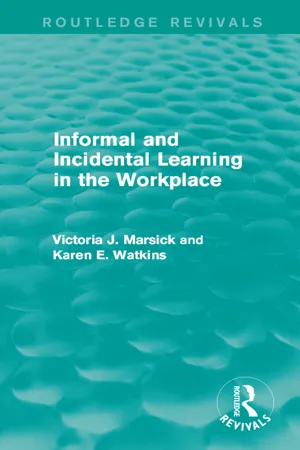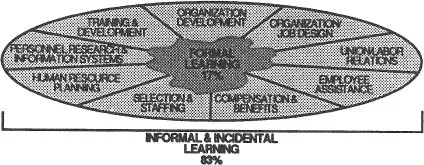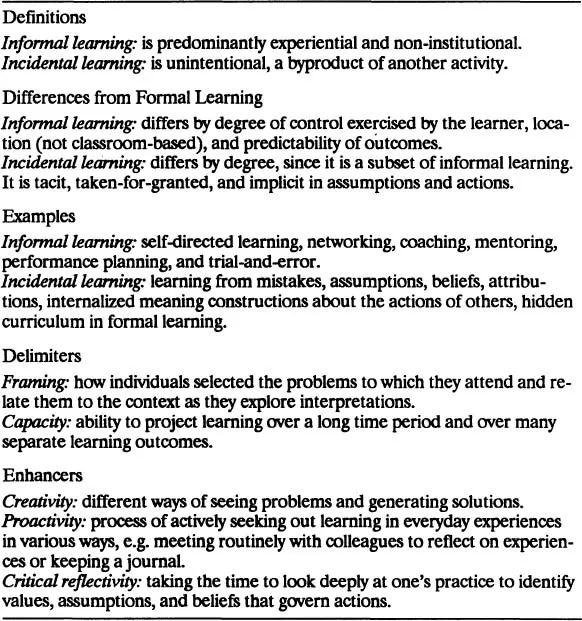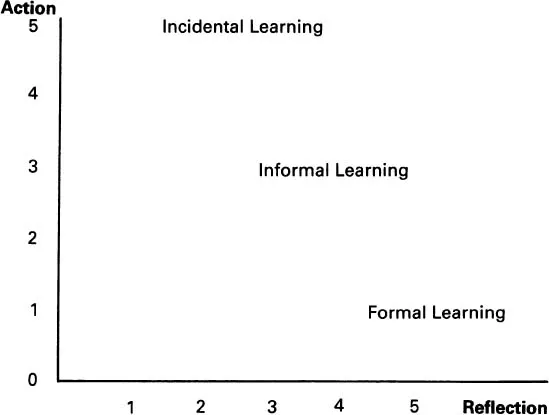![]()
Part One
Introduction
This book is written for those who are interested in informal and incidental learning in the workplace, which we contrast with more highly structured workshops, seminars and courses that are often referred to as training and development.
We are particularly interested in reaching people who work in human resource development because we believe that informal and incidental learning, which are difficult to organize and control, represent a neglected, but crucial, area of their practice. However, we also believe that learning is everyone’s responsibility in the workplace even though human resource developers should know more about helping to facilitate learning wherever it occurs, be it formal, informal, or incidental. One could use the point-of-sales analogy further to describe why this is important. When a product is sold, information is needed at the time the transaction takes place. The customer is at no time more motivated to learn than at the point-of-sale. The same is true for learning. People are obviously ready to learn when they are at the point-of-sale, so to speak, yet training and development is often treated as a commodity for which employees are scheduled at the convenience of the organization. By focusing on informal and incidental learning, we believe that employees will develop skills to facilitate more effectively both their own learning and that of others, at the point-of-sale, when they are experiencing a situation that demands learning.
Learning vs. training
In the pages that follow, we describe briefly what we mean by informal and incidental learning, and why we believe it to be so important to human resource developers. We also provide an overview of this book. We start by looking at training vs. learning.
As Marsick (1987a) describes elsewhere, training and education are delivery systems. By contrast we define learning more broadly as “the way in which individuals or groups acquire, interpret, reorganize, change or assimilate a related cluster of information, skills and feelings. It is also primary to the way in which people construct meaning in their personal and shared organizational lives” (p. 4). Learning might be limited to a specific change or reinterpretation, or it might take place over a longer period of time. Learning is sometimes identified through measurable changes in behavior or it may represent a change in an internal viewpoint that is difficult to quantify.
By emphasizing learning rather than training, we do not intend to devalue the importance of appropriate structured learning activities. However, we believe that an overriding interest in how best to organize learning through training has taken attention away from the natural opportunities for learning that occur every day in a person’s working life. Training usually refers to short-term activities that emphasize practical skills immediately applicable to the job. Training is sometimes, but not always, distinguished from longer-term courses that develop generic abilities and developmental activities.
By virtue of the fact that trainers design short-term activities, they typically select a discrete array of knowledge, skills, and attitudes that experts deem most appropriate to a topic the organization believes is important for its employees to master. The model most frequently used for training design in the United States, Instructional Systems Design, reflects this controlled focus on demonstrated performance with respect to desired behaviorally described objectives. The model works well when employees share an interest in the topic and can relate to the examples on which they practice.
However, learning then deals with situations out of one’s natural context. Employees may demonstrate that they have learned new knowledge and skills at the end of a training activity, but they find it difficult to transfer this learning to their normal work environment. We believe that people learn in the workplace through interactions with others in their daily work environments when the need to learn is greatest. Of course, people do not always learn from their experience and often, when they learn in this way, they may reinforce inaccurate ways of doing things. However, the potential exists to help people learn more effectively in the workplace by focusing on real life rather than on prescriptions, examples, and simulations.
In this book we highlight and describe informal and incidental learning, which has been left out of many definitions of the scope of training and development. In so doing, we reexamine linkages with training and with other functions in the organization that play a key role in learning outside the classroom. We are not advocating the elimination of training activities, but seek ways to enhance its linkage with informal and incidental learning.
The human resource learning circle
As Watkins (1989a) describes, a profession and a field of practice have grown up around workplace learning, usually referred to as training and development, but sometimes also called by the term human resource development, a broader umbrella term that encompasses a wide range of activities concerned with hiring, maintaining, and retiring an organization’s personnel pool. Training and development has grown from humble origins into a big business.
Figure I.1 The human resource wheel
Source: P. McLagan (1983). Reprinted with permission. All rights reserved.
Watkins explores the burgeoning growth of the field, the definition of which is still subject to controversy. Watkins notes a movement away from the early definition provided by Nadler (1983) which emphasized organized, job-specific learning activities toward a broadened identification with the full spectrum of human resources, illustrated in McLagan’s (1983) nine areas of practice in the human resource wheel (Figure 1.1). As we see in Figure 1.1, training and development is one small segment of the human resource wheel. By contrast, we take the position that learning is a primary function of all of these sectors. Learning, for example, plays a role in contract negotiations or provisions to be made to assist employees who suffer from debilitating diseases such as alcoholism or drug abuse.
Figure 1.2, the human resource learning circle, illustrates the relationship of learning to various areas of practice. The shape of the inner circle, formal learning, varies with the need for learning in different organizations and times. The learning pie is subdivided to show the approximate percentage of time and money spent on informal and incidental learning (83%), as opposed to formal learning (17%), based on annual estimates in Carnevale (1984).
Figure I.2 The human resource learning circle
Source: Adapted by V. J. Marsick and K. E. Watkins from P. McLagan (1983).
Preview of part one
Learning can take place in many situations: formal, informal, or incidental. In this book, we focus on informal and incidental learning to shed light on the phenomenon of learning, as seen from the learner’s point of view, rather than training, as seen from the trainer’s point of view. In Part One of this book, we define and describe informal and incidental learning, and discuss what we see as an emerging rationale for a renewed interest in learning in training. In this section, we provide an overview of key ideas introduced in these two chapters.
Informal and incidental learning
In Chapter One, we define and illustrate the concepts of informal and incidental learning by contrasting them with formal learning. Figure 1.3 summarizes characteristics that are then explained in Chapter One.
Informal and incidental learning both speak to learning outside formally structured, institutionally sponsored, classroom-based activities. As a result, both informal and incidental learning often take place under non-routine conditions, that is, when the procedures and responses that people normally use fail. In such cases, people may become aware of many tacit, hidden, taken-for-granted assumptions. In the process of doing this, people often reframe the problem they are experiencing, that is, they realize that a particular situation can be defined and solved in many different ways.
Informal and incidental learning, however, are not exactly the same. Incidental learning is defined as a byproduct of some other activity, such as task accomplishment, interpersonal interaction, sensing the organizational culture, or trial-and-error experimentation. As such, incidental learning is never planned or intentional, whereas informal learning can be planned or intentional, as for example, in self-directed learning or help consciously sought from coaches or mentors.
Figure I.3 Informal and incidental learning: a summary
An example might illustrate the distinction between informal and incidental learning. Informal learning can include many situations outside the classroom that are not designed in any detail, but that are planned. Susan may know that she needs skills in running meetings. To gain these skills, Susan might read about how to run meetings, might consult with her manager who seems to run meetings well, and might then seek out opportunities to practice these skills. Informal learning might also be accidental. Susan might participate in a quality circle that includes training in running meetings, or she might run into Robert who mentions an effective technique he has learned. Incidental learning, however, is never intentional and seldom explicit. It is serendipitous or coincidental with some other activity, and largely buried in the context of other tasks. For example, Susan might have had to give a report at a meeting of department heads, which she normally would not attend, that was not at all run well. Her incidental learning might be that it is not important to run meetings well.
Incidental learning is always delimited by the nature of the task that spurred its creation. For example, Susan might not be able to inquire into whether or not the meeting of department heads was always run in that fashion because her main purpose for participation was reporting on a specific project. It is always tacit, whereas informal learning may be more or less tacit; and success in this kind of learning always depends on the ability of the person to frame the problem appropriately. Incidental learning is also delimited by the work capacity of the individual, which is described in Chapter One in terms of Jaques’s (1988) work on goal-directed behavior in everyday work.
Finally, experience with successful informal and incidental learning suggests that it is enhanced by proactivity, critical reflectivity, and creativity. Proactivity refers to a readiness to take initiative in learning. Critical reflectivity is related to the surfacing and critiquing of tacit, taken-for-granted assumptions and beliefs that need to be examined in order for people to reframe problems. Creativity refers to the capacity of people to see a situation from many points of view, and to use new perspectives and insights to break out of preconceived patterns that inhibit learning.
There is no formula that guarantees learning, whether it is formally organized or not. People may or may not learn when they are on-the-job, in classrooms, observing others, or participating in structured or unstructured conversations. We can understand formal, informal, and incidental learning, as illustrated in Figure 1.4, in terms of the degree to which learning is characterized naturally by action or reflection. As described in this book, we find that learning takes place through an ongoing, dialectical process of action and reflection. To reflect, people must consciously become aware that they are learning. This involves a degree of intentionality. However, if reflection alone is emphasized, formal learning tends to be theoretical. Reflection is enhanced by the active application of concepts in practice. Informal and incidental learning, on the other hand, take place without much conscious reflection.
Figure I.4 Action and reflection in types of learning
Overview of this book
In Chapter One, we begin to develop a theory of informal and incidental learning. In Chapter Two, we step back and put this theory into the context of current developments in training and in human resource development so that we can better illustrate the value of a learning perspective in the field. We also introduce what we call the human resource learning cone as a framework for understanding various levels of formal, informal, and incidental learning in organizations. Building on the human resource learning circle, the learning cone is used to examine learning at the following four levels: 1) the individual, about whose learning we know the most; 2) the group in which many people naturally work; 3) the organization itself, influenced by top-level managers; 4) professional groups, whose learning is greatly influenced by norms set outside the organization.
Learning can take place at one of these four levels or, in many cases, at several of these levels simultaneously. The field of human resource development has paid more attention to individual learning, usually through formal classroom-based activities, even though the very nature of work in organizations argues for learning in groups and for organizational learning led by those who influence larger collective units. Professional learning is another growing, powerful force in workplace learning. We are particularly interested in the way in which human resource professionals learn since they influence greatly the strategies for learning that are open to others in the organization.
Each author introduces Part Two and Part Three with a preliminary description of the section’s focus and the way in which chapters fit together within it. The chapters are arranged to highlight one of the above levels of learning. We also illustrate different characteristics of informal and incidental learning as they are relevant to the information in the chapter and relate our findings to the theory presented in Part One.
Marsick, in Part Two, examines informal learning. In Chapter Three, she looks at the way in which individuals – managers in companies in Sweden – learn through fairly unstructured projects that are part of an innovative strategy for management development called action learning. Chapter Four focuses on the way in which educational field workers learn how to facilitate informal learning in communities. Chapter Five is concerned with professional adult educators in the workplace. She analyzes the way in which they have learned from their own experience and influence that of others.
Watkins, in Part Three, examines incidental learning. In Chapter Six, she looks at the incidental learning of individuals, in this case, professionals who examine the way in which their experiences as children growing up in alcoholic families have influenced their responses to working and learning in the workplace. In Chapter Seven, Watkins focuses on learning at the organizational level by looking at the way in which key leaders in postsecondary institutions respond to change and innovation. In this chapter she describes the way in which incidental learning takes place under non-routine conditions when innovations are introduced for which there is no preferred, known way of managing. In Chapter Eight, Watkins addresses the professional level of learning by describing the way in which human resource developers are influenced by the assumptions they hold about learning. These professionals learn incidentally as they begin to highlight tacit beliefs and challenge them through critical reflection.
Table 1.1 shows the primary level of learning addressed by each of these chapters as well as the key dimensions of informal or incidental learning, discussed in Chapter One, that are illustrated by that chapter. The reader will note that Part ...




